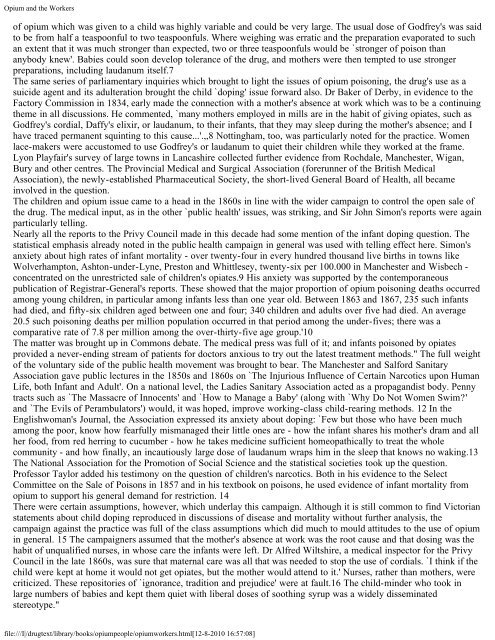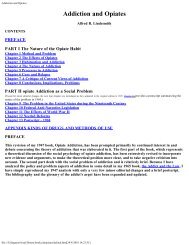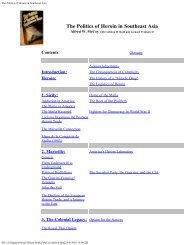opium and the people
opium and the people
opium and the people
Create successful ePaper yourself
Turn your PDF publications into a flip-book with our unique Google optimized e-Paper software.
Opium <strong>and</strong> <strong>the</strong> Workers<br />
of <strong>opium</strong> which was given to a child was highly variable <strong>and</strong> could be very large. The usual dose of Godfrey's was said<br />
to be from half a teaspoonful to two teaspoonfuls. Where weighing was erratic <strong>and</strong> <strong>the</strong> preparation evaporated to such<br />
an extent that it was much stronger than expected, two or three teaspoonfuls would be `stronger of poison than<br />
anybody knew'. Babies could soon develop tolerance of <strong>the</strong> drug, <strong>and</strong> mo<strong>the</strong>rs were <strong>the</strong>n tempted to use stronger<br />
preparations, including laudanum itself.7<br />
The same series of parliamentary inquiries which brought to light <strong>the</strong> issues of <strong>opium</strong> poisoning, <strong>the</strong> drug's use as a<br />
suicide agent <strong>and</strong> its adulteration brought <strong>the</strong> child `doping' issue forward also. Dr Baker of Derby, in evidence to <strong>the</strong><br />
Factory Commission in 1834, early made <strong>the</strong> connection with a mo<strong>the</strong>r's absence at work which was to be a continuing<br />
<strong>the</strong>me in all discussions. He commented, `many mo<strong>the</strong>rs employed in mills are in <strong>the</strong> habit of giving opiates, such as<br />
Godfrey's cordial, Daffy's elixir, or laudanum, to <strong>the</strong>ir infants, that <strong>the</strong>y may sleep during <strong>the</strong> mo<strong>the</strong>r's absence; <strong>and</strong> I<br />
have traced permanent squinting to this cause...'.,,8 Nottingham, too, was particularly noted for <strong>the</strong> practice. Women<br />
lace-makers were accustomed to use Godfrey's or laudanum to quiet <strong>the</strong>ir children while <strong>the</strong>y worked at <strong>the</strong> frame.<br />
Lyon Playfair's survey of large towns in Lancashire collected fur<strong>the</strong>r evidence from Rochdale, Manchester, Wigan,<br />
Bury <strong>and</strong> o<strong>the</strong>r centres. The Provincial Medical <strong>and</strong> Surgical Association (forerunner of <strong>the</strong> British Medical<br />
Association), <strong>the</strong> newly-established Pharmaceutical Society, <strong>the</strong> short-lived General Board of Health, all became<br />
involved in <strong>the</strong> question.<br />
The children <strong>and</strong> <strong>opium</strong> issue came to a head in <strong>the</strong> 1860s in line with <strong>the</strong> wider campaign to control <strong>the</strong> open sale of<br />
<strong>the</strong> drug. The medical input, as in <strong>the</strong> o<strong>the</strong>r `public health' issues, was striking, <strong>and</strong> Sir John Simon's reports were again<br />
particularly telling.<br />
Nearly all <strong>the</strong> reports to <strong>the</strong> Privy Council made in this decade had some mention of <strong>the</strong> infant doping question. The<br />
statistical emphasis already noted in <strong>the</strong> public health campaign in general was used with telling effect here. Simon's<br />
anxiety about high rates of infant mortality - over twenty-four in every hundred thous<strong>and</strong> live births in towns like<br />
Wolverhampton, Ashton-under-Lyne, Preston <strong>and</strong> Whittlesey, twenty-six per 100.000 in Manchester <strong>and</strong> Wisbech -<br />
concentrated on <strong>the</strong> unrestricted sale of children's opiates.9 His anxiety was supported by <strong>the</strong> contemporaneous<br />
publication of Registrar-General's reports. These showed that <strong>the</strong> major proportion of <strong>opium</strong> poisoning deaths occurred<br />
among young children, in particular among infants less than one year old. Between 1863 <strong>and</strong> 1867, 235 such infants<br />
had died, <strong>and</strong> fifty-six children aged between one <strong>and</strong> four; 340 children <strong>and</strong> adults over five had died. An average<br />
20.5 such poisoning deaths per million population occurred in that period among <strong>the</strong> under-fives; <strong>the</strong>re was a<br />
comparative rate of 7.8 per million among <strong>the</strong> over-thirty-five age group.'10<br />
The matter was brought up in Commons debate. The medical press was full of it; <strong>and</strong> infants poisoned by opiates<br />
provided a never-ending stream of patients for doctors anxious to try out <strong>the</strong> latest treatment methods." The full weight<br />
of <strong>the</strong> voluntary side of <strong>the</strong> public health movement was brought to bear. The Manchester <strong>and</strong> Salford Sanitary<br />
Association gave public lectures in <strong>the</strong> 1850s <strong>and</strong> 1860s on `The Injurious Influence of Certain Narcotics upon Human<br />
Life, both Infant <strong>and</strong> Adult'. On a national level, <strong>the</strong> Ladies Sanitary Association acted as a propag<strong>and</strong>ist body. Penny<br />
tracts such as `The Massacre of Innocents' <strong>and</strong> `How to Manage a Baby' (along with `Why Do Not Women Swim?'<br />
<strong>and</strong> `The Evils of Perambulators') would, it was hoped, improve working-class child-rearing methods. 12 In <strong>the</strong><br />
Englishwoman's Journal, <strong>the</strong> Association expressed its anxiety about doping: `Few but those who have been much<br />
among <strong>the</strong> poor, know how fearfully mismanaged <strong>the</strong>ir little ones are - how <strong>the</strong> infant shares his mo<strong>the</strong>r's dram <strong>and</strong> all<br />
her food, from red herring to cucumber - how he takes medicine sufficient homeopathically to treat <strong>the</strong> whole<br />
community - <strong>and</strong> how finally, an incautiously large dose of laudanum wraps him in <strong>the</strong> sleep that knows no waking.13<br />
The National Association for <strong>the</strong> Promotion of Social Science <strong>and</strong> <strong>the</strong> statistical societies took up <strong>the</strong> question.<br />
Professor Taylor added his testimony on <strong>the</strong> question of children's narcotics. Both in his evidence to <strong>the</strong> Select<br />
Committee on <strong>the</strong> Sale of Poisons in 1857 <strong>and</strong> in his textbook on poisons, he used evidence of infant mortality from<br />
<strong>opium</strong> to support his general dem<strong>and</strong> for restriction. 14<br />
There were certain assumptions, however, which underlay this campaign. Although it is still common to find Victorian<br />
statements about child doping reproduced in discussions of disease <strong>and</strong> mortality without fur<strong>the</strong>r analysis, <strong>the</strong><br />
campaign against <strong>the</strong> practice was full of <strong>the</strong> class assumptions which did much to mould attitudes to <strong>the</strong> use of <strong>opium</strong><br />
in general. 15 The campaigners assumed that <strong>the</strong> mo<strong>the</strong>r's absence at work was <strong>the</strong> root cause <strong>and</strong> that dosing was <strong>the</strong><br />
habit of unqualified nurses, in whose care <strong>the</strong> infants were left. Dr Alfred Wiltshire, a medical inspector for <strong>the</strong> Privy<br />
Council in <strong>the</strong> late 1860s, was sure that maternal care was all that was needed to stop <strong>the</strong> use of cordials. `I think if <strong>the</strong><br />
child were kept at home it would not get opiates, but <strong>the</strong> mo<strong>the</strong>r would attend to it.' Nurses, ra<strong>the</strong>r than mo<strong>the</strong>rs, were<br />
criticized. These repositories of `ignorance, tradition <strong>and</strong> prejudice' were at fault.16 The child-minder who took in<br />
large numbers of babies <strong>and</strong> kept <strong>the</strong>m quiet with liberal doses of soothing syrup was a widely disseminated<br />
stereotype."<br />
file:///I|/drugtext/library/books/<strong>opium</strong><strong>people</strong>/<strong>opium</strong>workers.html[12-8-2010 16:57:08]





